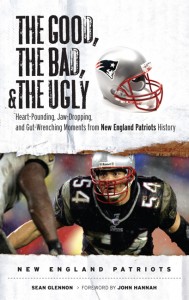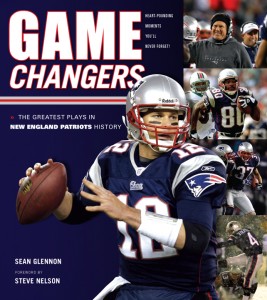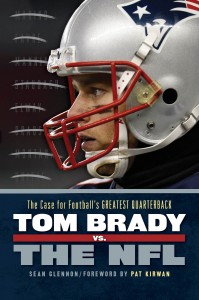With the news breaking that Jack Tatum has died, I thought I’d post the section of The Good, the Bad & the Ugly: Heart-Pounding, Jaw-Dropping and Gut-Wrenching Moments from New England Patriots History that deals with what Tatum did to the late Darryl Stingley.
This isn’t about passing judgment or speaking ill of the dead. It’s just about remembering a man for who he was: a great football player, sure, but not such a great human being.
The Worst Injury In Patriots History: Darryl Stingley
There comes a moment once every three or four seasons when we’re reminded, suddenly, painfully, horribly, of what a savage sport football can be.
Ninety percent of the time, it begins with nothing more than two players doing their jobs. An offensive player doing everything he can to advance the ball. A defender going all out to stop him. A collision. Brutal. But in nearly every important way not unlike the scores of other brutal collisions that take place on fields across the country every Sunday through the fall and early winter.
Then one of the players involved — usually the one who took the hit rather than the one who administered it — fails to get up. And it starts to become clear that he hasn’t simply had the wind knocked out of him. And that what’s happened isn’t merely game ending or season ending, but career ending.
Sometimes the replay shows precisely what happened. Joe Theismann’s leg snaps like dry kindling under the weight and power of Lawrence Taylor. Sometimes it’s not so clear. Buffalo Bills tight end Kevin Everett, while pitching in on special teams, goes down after a collision with Denver Broncos kick returner Domenik Hixon with what will later be revealed as a spinal injury. Either way, by the time you see the injured player being carried off the field, you know it’s the last time you’ll ever see him in pads and a uniform.
It’s the worst part of the game.
Almost no one who wasn’t present in Oakland, California on August 12, 1978 saw Darryl Stingley being carried off the field. It was the pre-season. It was the ’70s, long before cable TV and ravenous fans turned every minor occurrence in the NFL into a media event. It was the middle of summer, when people had better things to do than follow exhibition football games.
By the end of the day, however, most football fans — and especially those in New England — not only had heard about Stingley’s injury, but had seen the hit that caused it on the evening news. Many have seen it more than a few times since. And every time, it’s as brutal and horrific — and as stunningly ordinary — as the last.
Stingley, the wide receiver, extends, putting in the extra effort that was his stock in trade in an attempt to pull down a pass from quarterback Steve Grogan that had sailed a bit too high. Doing his job. Then Oakland Raiders safety Jack Tatum comes flying in, full of the fury he was famous for, and pulverizes Stingley. Tatum’s forearm and helmet crash into Stingley’s helmet, hammering the defenseless receiver to the ground. Stingley collapses to the field. And he never makes it back to his feet. Never.
Stingley would never walk, nor even use an arm in any real way, after that hit. The two broken vertebrae he suffered in that pre-season game left Stingley a quadriplegic. The injury also led to Stingley’s early death on April 5, 2007 at the age of 55.
There remains, even 30 years later with Stingley in the ground and Tatum reportedly losing a long battle with diabetes, division over the hit that cost Stingley almost everything.
There are those who believe the hit was unnecessarily vicious, dirty, and uncalled for. It was a pre-season game with nothing meaningful on the line, they argue. Tatum should have recognized that Stingley had no hope of catching the pass and pulled up.
Grogan is one of those. He has maintained over the years that the hit was late and that Tatum had to know the play was effectively over before he ever got to Stingley. Grogan also hasn’t been shy about criticizing Tatum for they way acted immediately after the hit and in all the years thereafter.
Tatum never made any attempt to show remorse for what had happened or concern for the man he’d crippled. While his coach, John Madden, and teammates spent time with Stingley in the hospital, Tatum stayed away, insisting he had nothing to say to the injured player. And not only did Tatum’s position on the matter never soften, he made something of a post-football career out of sneering at Stingley.
Tatum, who always embraced his nickname, “Assassin,” has written three books about his experiences in the NFL, They Call Me Assassin, They Still Call Me Assassin, and Final Confessions of an NFL Assassin. In each of them, Tatum celebrates his crushing playing style, taking pride in the fact that the hits he administered frequently seemed designed not to stop offensive players but to injure them. In his last book, Tatum criticized defensive players who came along after his time for not being savage enough, claiming that if he’d played the way current players do “Darryl Stingley wouldn’t be confined to a wheelchair.”
And that approach to the incident has always placed Tatum well outside the range of normal, understandable human behavior. Even the hardest hitters in the game have typically expressed horror when their play has resulted in serious injury. Taylor, for instance, not only frantically called for medical attention for Theismann after his famous hit, but broke down on the field, and has said he has never been able to watch the play.
That Tatum not only insists he did nothing wrong in his hit on Stingley, but actually boasts of the results, certainly colors the way Grogan and other critics perceive the events.
“It was Jack Tatum that was the real problem, when he was bragging about the fact that he had done what he’d done to Darryl,” Grogan said in an interview on Boston sports radio station WEEI the day Stingley died. “That was what was hard to take.”
Looking at the hit, it’s hard not to conclude that Tatum’s personality was ultimately more problematic than his play.
The blow Tatum delivered to Stingley was without question intended to punish. Tatum clearly wanted to make sure Stingley would forever be looking over his shoulder any time the two men found themselves on the same field.
Tatum had to know that was the only way you slowed a receiver like Stingley, a possession guy whose greatest quality was that he put every bit of himself into every play whether he was throwing a block (not an unusual role for a receiver in Chuck Fairbanks and Ron Erhardt’s run-oriented offense) or making tough catches while operating against tight coverage underneath. Stingley wasn’t always the most gifted receiver on a field (though sometimes he was), but he was usually the hardest working. And the toughest. If you didn’t get into his head, he posed a continuous threat.
But Tatum’s hit was legal at the time. (It was partially as a result of that play that rules were later put in place protective defenseless receivers. And it’s those rules, in combination with rules protecting quarterbacks, that have made the passing game such a huge part of professional football.) It may have been ill-advised. It may have been unnecessary. But it was within the rules. And Tatum was simply playing the way he always played – whatever anyone might think of that.
That doesn’t change anything, of course. It doesn’t give Stingley his legs, or his life, back. It doesn’t change the fact that the Patriots lost a player who was a leader on the field and off, a player who’d led the team in receptions in the previous season and who might have had another half dozen good to great years in him.
It doesn’t make Tatum any less wrong for the way he handled himself after that day, either. The only thing that ever could have redeemed Tatum would have been an apology. And now, as of April 5, 2007, it will always be too late for that.



